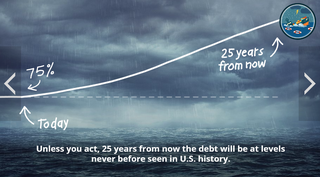Posted by Brendan Mochoruk and David Wessel[1]
How to use a computer game to elevate public debate over the U.S. Federal deficit? The mission of the Hutchins Center at the Brookings Institution www.brookings.edu/hutchinscenter is to improve both the quality of fiscal and monetary policy and public understanding of it. Finding ways to explain fiscal realities to people who know that the federal debt is important but never get to the end of any newspaper story on the subject can be difficult. Mention the federal budget and eyes glaze over.
Our challenge was to engage these people, young and old, so that they are better informed citizens. We wanted them to understand that the U.S. doesn’t face a big problem with this year’s budget deficit or next, but that the federal budget is on an unsustainable course. We wanted to remind them that fiscal policy is not just about the numbers, but also about what role government plays in the economy. And we wanted to show them that it’s possible – not easy, but possible – to pursue their own priorities for the government (reducing inequality, shrinking government, fighting climate change, bolstering national defense) while stabilizing the federal debt.
Like other think tanks, we commission papers, write blog posts, host events and do short YouTube videos. But for this project, we wanted to reach a broader audience, so we teamed up with the Woodrow Wilson Center for International Scholars https://www.wilsoncenter.org/ to create a computer game, The Fiscal Ship [www.fiscalship.org], with funding from three foundations (Peter G. Peterson, William and Flora Hewlett and Richard Lounsbery).
How The Fiscal Ship works
In the game, which can be played on a desktop, tablet or phone, players begin by choosing up to three governing goals from the 10 we have offered them.
Then players are confronted with the latest projections showing that, given current polices, the federal debt will rise as a share of the economy over the next 25 years to about 130% of the gross domestic product. The mission is to pick tax and spending policies that achieve the selected governing goals and reduce the projected debt so that by 2041, it is at about 75% of GDP, where it is today.
Along the way, players discover how much money would be raised by imposing a $25-a-ton carbon tax or how much (or how little) would be saved by abolishing the Department of Education. They see how small an impact some widely discussed budget policies would have, and how hard it is to solve the puzzle without picking some policies that are, at least right now, politically difficult. Click here to see a quick video on how to play.
What we’ve learned so far
In the six weeks following the launch of The Fiscal Ship, it has been played more than 41,000 times by about 31,000 unique visitors. It has been most popular with people between 25 to 34 years old Perhaps unsurprisingly given the age breakdown of players, “Protect the Elderly” has been selected in only 5% of games played. “Invest in the Future” has been the most popular governing goal choice, selected in 40% of all playthroughs.
Excluding those who leave the first screen after only a few seconds, nearly half the players are spending 10 minutes or more on the game, which we find very encouraging. We’ve heard from college professors who are using the game in the classroom, assigning one team of students a more conservative set of governing goals and another a more liberal one and then seeing how they reached fiscal sustainability by very different routes. We’ve had journalists play the game to illuminate the differences among the presidential candidates – and the arithmetic impossibility of keeping all the promises that some candidates have made.
We’ve gotten a lot of great feedback from players over the past few weeks, as well as a few recurring questions. Among them: Why is the debt to GDP target set at 75%? It was a somewhat arbitrary decision. There’s no magic number—some argue that that a target of 75% is too low, some argue that it’s not low enough – but there is general agreement that the current trajectory of ever-rising debt is risky. We decided that 75%—roughly today’s level—is a reasonable middle ground. Players can choose a “Fiscal Hawk” goal and aim to reduce the debt-to-GDP ratio to the 50-year average, around 38%.
Another common question: Why no dynamic scoring? That is, why not allow some policies to boost the GDP? Because it’s really difficult to do well, and impossible to do on all but the biggest changes in policy. Doing a dynamic score for each of the 100-plus policies in the game just isn’t possible. For more on these and other questions, check out our Frequently Asked Questions fiscalship.org/FAQ.phppage.
[1] Hutchins Center on Fiscal and Monetary Policy at the Brooking Institution, Washington DC.
Note: The posts on the IMF PFM Blog should not be reported as representing the views of the IMF. The views expressed are those of the authors and do not necessarily represent those of the IMF or IMF policy.











